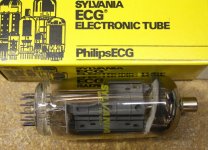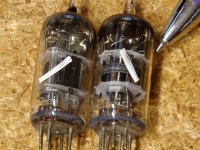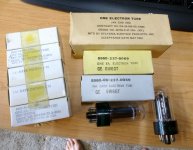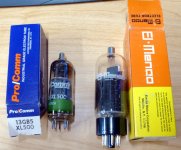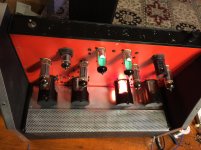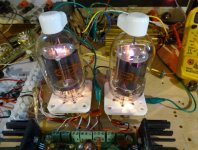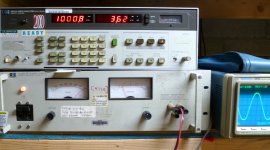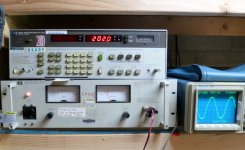good that i do not have ones with green rings....😀
I have 18GB5 (EL Menco) with green ring bands...are they not good?
El Menco were Electro-Motive house brand (GM) as far as I can recollect and purchased tubes from reputable makers like Mullard, RCA, GE, etc.. What you have are probably just fine, the El Menco branded tubes I've had in the past all worked just fine.
Tubelab, those Sylvania tubes don't look like late production, coin base and blue Sylvania logo or Philips were final production vintage. I'm wondering what exactly happened to those tubes? (I worked for GTE at the time Sylvania consumer electronics division and ECG were sold to Philips)
Tubelab, those Sylvania tubes don't look like late production, coin base and blue Sylvania logo or Philips were final production vintage. I'm wondering what exactly happened to those tubes? (I worked for GTE at the time Sylvania consumer electronics division and ECG were sold to Philips)
Sylvania tubes don't look like late production
I don't know when they were made. They are the green label often viewed as good sounding tubes by those who attach "status" to certain tubes. There is a vertical number 705 next to a horizontal ABH which I assume to be a date code. According to the date coding we (Motorola semiconductors) used at the time these could have been from the 5th week of 67, or 77. My guess is 1967 since they came from NASA at the Cape Canaveral launch site, and the tube stuff went out in 70's. They were in a lot of surplus equipment that was auctioned off in the mid 80's. I was on site at the auction and all the tubes went directly into my car....my share for helping to load the trucks.
I'm wondering what exactly happened to those tubes?
My guess is there was some contamination during manufacturing, likely in the base where the leads go through the glass, since almost all of these tubes have been slowly dying.
I went through all the tubes when I got them. The 6V6GTA's were the only tubes with visible problems, so I tested them in a guitar amp, and there were a lot of bad ones, all gassy. They were tossed, and the rest were left in the bulk pack box on a shelf in my air conditioned room. I used a few in guitar amps over the years, and there were too many ugly failures, so I quit using them.
I opened the box during the development of the SSE (2006 - 2007), and found that about half of the remaining tubes had gone gassy just sitting on the shelf. Some of the bad ones were blown up in the pictures.
I tested the remaining good tubes in an SSE (42 out of 100) and packed the good ones (36) in a box and taped it up when I was preparing to move out of Florida, about 4 years ago. I opened this box this morning to find two more with zero getter at all, and several with obvious degradation. Maybe it's time to "test" a few more.
I will not trust these tubes in anything, but I have a pair that have played well in an SSE since 2008 that operates slightly above dissipation spec, so there are a few good ones.
I got a lot of 45 Sylvania ECG 35LR6's that are from much later. All of these tubes have obvious manufacturing defects, and some have failed in a spectacular manner.....yes I am bending the specs on them, but that's not causing the failures.....the internal elements are falling out, or coming loose and touching each other. BIG SPARKS happen. None of the tabs on the top and bottom of the beam plate, or the main plate are bent over and the grids are not crimped, so things vibrate out of place. Some of the mica spacers have come loose. I found one where the heater had come out of the cathode.
The seller pointed this out when I bought them and sold them cheap. He had several hundred Sylvania ECG tubes, all in retail boxes, all with problems. He claimed that they were pulled from the shelves at a major electronics distributor due to these manufacturing defects.
All the manufacturers screw up sometimes......this one is my favorite. I found TWO of these when I was sorting through 100,000 tubes, and have since found a third. ALL of these were removed from vintage military spares, and all work!
Attachments
The green ones should be mid 1960s vintage as I recall.
I've never run into significant issues with any of the Sylvania tubes I've picked up surplus, but most of my military spares are in white boxes. The rest are ones I've picked up in old TV shops, hamfests and on eBay.
I'm wondering whether someone figured that most of these tubes were unlikely to be used or even looked at and just grabbed and shipped whatever was on hand.
I've got 80 year old tubes that are perfectly fine after all of these decades from various brands.
I've never run into significant issues with any of the Sylvania tubes I've picked up surplus, but most of my military spares are in white boxes. The rest are ones I've picked up in old TV shops, hamfests and on eBay.
I'm wondering whether someone figured that most of these tubes were unlikely to be used or even looked at and just grabbed and shipped whatever was on hand.
I've got 80 year old tubes that are perfectly fine after all of these decades from various brands.
On those El Menco 13GB5s with the green band, I would compare the plates with the pics in post 98 above. The holes in the plates along the support edges are fairly unique.
-------------
I have a Zenith 36MC6 here (probably RCA made) from Ebay that has the grids perfectly mis-aligned. It has been valuable in sorting out some effects on the curve tracer. A grid or plate that is sufficiently far from the cathode is typicaly 1.5 power law (V to I) for a triode say. But the aligned grid 2 in beam tetrodes are more like 1.3 to 1.4 power law. (which makes for triodes that are just a little different, Mu variation, from real triodes typically) The alignment apparently provides an anti grid wire proximity effect, or shielding. Opposite to what one sees for a closely spaced grid 1, where its power law gets boosted above 1.5 from proximity effects.
The perfectly mis-aligned 36MC6 does not show the anti effect for g2. And it makes an excellent triode. It also draws g2 current like crazy. In fact, it suffers from nearly the same effect seen with the PoorComm 13GB5. Its plate curves collapse down after running for a while on the tracer. However, it fully recovers after cooling down again.
(I feel guilty now for accepting a refund on the tube, but it definitely won't be getting used in any amplifier. I keep it on the shelf in a specially marked box for "studies".)
I've heard that all the pin seals on tubes leak, just a matter of log scale. Eventually all old tubes will fail with white getters. Helium leaks through especially well. And hot glass becomes semi-permeable too. There is an experiment I've seen where a tube is operated in a molten salt with an electric field between inside and out, it draws ions into the glass and the vacuum.
-------------
I have a Zenith 36MC6 here (probably RCA made) from Ebay that has the grids perfectly mis-aligned. It has been valuable in sorting out some effects on the curve tracer. A grid or plate that is sufficiently far from the cathode is typicaly 1.5 power law (V to I) for a triode say. But the aligned grid 2 in beam tetrodes are more like 1.3 to 1.4 power law. (which makes for triodes that are just a little different, Mu variation, from real triodes typically) The alignment apparently provides an anti grid wire proximity effect, or shielding. Opposite to what one sees for a closely spaced grid 1, where its power law gets boosted above 1.5 from proximity effects.
The perfectly mis-aligned 36MC6 does not show the anti effect for g2. And it makes an excellent triode. It also draws g2 current like crazy. In fact, it suffers from nearly the same effect seen with the PoorComm 13GB5. Its plate curves collapse down after running for a while on the tracer. However, it fully recovers after cooling down again.
(I feel guilty now for accepting a refund on the tube, but it definitely won't be getting used in any amplifier. I keep it on the shelf in a specially marked box for "studies".)
I've heard that all the pin seals on tubes leak, just a matter of log scale. Eventually all old tubes will fail with white getters. Helium leaks through especially well. And hot glass becomes semi-permeable too. There is an experiment I've seen where a tube is operated in a molten salt with an electric field between inside and out, it draws ions into the glass and the vacuum.
Last edited:
but most of my military spares are in white boxes
The color of the boxes depends on who, and when they were packaged. Most of the WWII and before military tubes were packaged in unbleached cardboard. The big tube is in a lighter shade of natural colored cardboard, as are many of the tubes from that era. It was packaged in 1952. The yellowish 6W6GT is from 1966. I have seen white, yellow, brown, and grey packaging from the 60's. The light grey box is from 1975 and the white ones are from 1976.
I have a friend who has been in the surplus business since we were in high school together. I helped him with some of his larger transactions over the years, usually in exchange for a piece of equipment, transformers, or tubes. Sometimes I just got lucky and got free, or very cheap stuff for being in the right place at the right time.
One day about 15 years ago I got a phone call from him. He had acquired 25,000 sq foot of surplus "stuff" in a derelict building. Apparently the original owner had collected all sorts of WWII and Korean war "stuff" and then passed away about 10 years previous to this. The building was deemed unsafe, and the land was sold at a tax auction. Demo had begun on the building when one of the dozer operators discovered a partially disassembled airplane inside. My friend got a call. He had to get in, get what he wanted, and get out. I was told that I could take all the tubes and pretty much anything else I could grab....bring a large truck, it was 200+ miles away.
There were tubes, and parts everywhere, mostly broken. Over three weekends I collected 100,000+ loose tubes. They had been carefully pulled from an immense pile of military spare assemblies dating from 1939 to 1960, all arranged on wooden shelving, which had rotted and collapsed. There must have been 100 or more 833A's, 211's and 845's broken on the floor.
It took my about 6 years to sort all the tubes, and pick about 10,000 or so that I kept. The 6AG5's with the extra heaters inside were in that lot.
I have 18GB5 (EL Menco) with green ring bands...are they not good? .....El Menco were Electro-Motive house brand
I remember El-Menco capacitors from the 50's and 60's. I never saw an El-Menco tube until about 1975. I did some Googling and came up with this, from another forum.
El-Menco was a well-known name in capacitors. Whether the parent company, Electro-Motive Corp. marketed tubes themselves or just licensed their name, Their line was limited to the most common types. They lacked brand name recognition, although with their famous capacitor name, among electronic techs, they should have been known. Most of their tubes are from Japan, but some are USA. IEC bought Electromotive Corp. in 1965 and began marketing tubes under the El Menco name, presumably for the brand recognition.
The El-Menco tube that I have in this picture is a Sylvania. The ProComm 13GB5 next to it is the Korean junk tube. The text above indicates that many El-Menco tubes are Japanese. The Japanese sweep tubes often use the green ring, but it is usually not as wide. The green paint, or the metal ring, is made of some material that is Lossy at RF frequencies, and helps prevent oscillation. Most Japanese tubes are pretty good, but I don't have any here for comparison.
Attachments
I recently put random Gu-50 tubes in my amp, and fired it up. The amp was playing, when I smelled a hot iron. One tube had yellow anode. I powered it off, and 15 minutes later powered on, tested bias; the current of the tube was even lower, so I re-adjusted it carefully. Since then the amp works fine, no problems with the tube. Looks like it had some gas (NOS, from 1970'Th), and orange anode caused it's absorption. The tube was designed by Telefunken for military, with nickel alloy anode looking as if covered by some grey powder.
Attachments
I've owned a few El-Menco EL34s - they were Matsushita made.
rumor has it that these were the best sounding el34's ever....😉
Yeah, but what the h***... as long as you can at least find it at a hamfest, I'll gladly look the other way! 😀OK, so it's not one of those "magnificent TV tubes"........
A picture of the 6CB5A tube types traced .
Top to bottom: RCA grey round, Sylvania grey round, RCA grey rectangular, "Sylvania/National" black plate
I don't have any of the old "coke bottle" types.
The rectangle plate 6CB5A with the square cutouts in the plate is a beast. I built a triode strapped SE amp with them, and then bought a few other models. All of which you pictured. They all red plated to some extent. The rectangle ones I tested all stayed perfectly grey all day long. Plus, they seemed to have the prettiest blue glow of all of them 🙂
OK, so it's not one of those "magnificent TV tubes"........
more...more please....😀 did you torture them?
It took 2 and a half hours to get Tony's attention.....I think he has waited a long time for me to light these things up....
Yes, and no. The setup I used for this test has limitations. The OPT that is hiding behind one tube is rated for 80 watts, and was designed for a guitar amp. The load resistor behind the other tube is rated for 125 watts, and that is on a heat sink......plywood doesn't cut it as a heat sink.
So what got abused, the tubes, the OPT, or the load resistor?
Well, 2 out of 3 isn't bad.
For those that don't know, these tubes are the 4D32's shown in the schematic in post #54. They are transmitting tubes that are used in a Collins transmitter. The data sheet gives the characteristics for an AB2 audio amplifier that should deliver 125 watts into a 3000 ohm load from a 600 volt supply. The data sheet is too big to attach here, over 1MB.
I wired a pair of sockets into my breadboard, and adjusted everything to duplicate the conditions shown in the data sheet, (600V plate, 250V screen)except my OPT is 3300 ohms. I hit the switch and adjusted the bias for the prescribed 50 mA per tube. I turned up the audio generator until I hit clipping. Nothing bad happened, so I turned the power supply up as far as it would go, 658 volts. Again nothing bad happened. Not even a hint of glow from anything. The OPT remained cool, but the load resistor didn't.
A previous experiment years ago, with different tubes, but another of the exact same OPT's ended with the OPT ON FIRE when the load resistor blew open at full power leaving the amp with no load. These OPT's were never designed to eat 650 volts of B+!!!!!
So, at the moment I have taken the breadboard apart, and am modifying it to accommodate "Crazy Drive" a bigger OPT, and a bigger load resistor...if I can find it. If not, I'll use two of the gold ones.
I let the load cool off and went back and measured THD VS Power Out.....I don't have FFT functions yet.....still looking through boxes for some missing pieces, like the license dongle. Test results:
0.5W 0.186%
1.0W 0.188%
2.0W 0.195%
5.0W 0.338%
10W 0.673%
20W 1.005%
50W 1.181%
100W 1.384%
150W 1.419%
200W 2.93% just beginning to clip.
More screen voltage did not produce any more power, just sucked more current. I believe more power requires more voltage, which I don't have, or a lower load impedance. I do have a 400 Watt 2500 ohm OPT.....
Stay tuned.....
more...more please.... did you torture them?
Yes, and no. The setup I used for this test has limitations. The OPT that is hiding behind one tube is rated for 80 watts, and was designed for a guitar amp. The load resistor behind the other tube is rated for 125 watts, and that is on a heat sink......plywood doesn't cut it as a heat sink.
So what got abused, the tubes, the OPT, or the load resistor?
Well, 2 out of 3 isn't bad.
For those that don't know, these tubes are the 4D32's shown in the schematic in post #54. They are transmitting tubes that are used in a Collins transmitter. The data sheet gives the characteristics for an AB2 audio amplifier that should deliver 125 watts into a 3000 ohm load from a 600 volt supply. The data sheet is too big to attach here, over 1MB.
I wired a pair of sockets into my breadboard, and adjusted everything to duplicate the conditions shown in the data sheet, (600V plate, 250V screen)except my OPT is 3300 ohms. I hit the switch and adjusted the bias for the prescribed 50 mA per tube. I turned up the audio generator until I hit clipping. Nothing bad happened, so I turned the power supply up as far as it would go, 658 volts. Again nothing bad happened. Not even a hint of glow from anything. The OPT remained cool, but the load resistor didn't.
A previous experiment years ago, with different tubes, but another of the exact same OPT's ended with the OPT ON FIRE when the load resistor blew open at full power leaving the amp with no load. These OPT's were never designed to eat 650 volts of B+!!!!!
So, at the moment I have taken the breadboard apart, and am modifying it to accommodate "Crazy Drive" a bigger OPT, and a bigger load resistor...if I can find it. If not, I'll use two of the gold ones.
I let the load cool off and went back and measured THD VS Power Out.....I don't have FFT functions yet.....still looking through boxes for some missing pieces, like the license dongle. Test results:
0.5W 0.186%
1.0W 0.188%
2.0W 0.195%
5.0W 0.338%
10W 0.673%
20W 1.005%
50W 1.181%
100W 1.384%
150W 1.419%
200W 2.93% just beginning to clip.
More screen voltage did not produce any more power, just sucked more current. I believe more power requires more voltage, which I don't have, or a lower load impedance. I do have a 400 Watt 2500 ohm OPT.....
Stay tuned.....
Attachments
you're the man George......
what grid leak resistor did you use? and did you use GNFB?
now that you are on to transmitting tubes, have you tested the 829b's yes?
sorry lot's of questions....

what grid leak resistor did you use? and did you use GNFB?
now that you are on to transmitting tubes, have you tested the 829b's yes?
sorry lot's of questions....
The tube is directly driven by a mosfet follower with about 20K of resistance to the negative supply. The mosfet has an on resistance of about an ohm to the positive supply, so the grid is well controlled.
Driver board schematic enclosed.....there is an off board 24K in parallel with that 82 K on the board, for about a 20K resistance. I use a high resistance for screen drive and other applications where the DC voltage is high enough to cook a little resistor.
There is no feedback of any sort for these tests.
I don't think I have any 829's anymore. I have had to pack up everything and move it all, twice in the past two years. I sold, gave away or tossed a whole lot of stuff.....the first move was 1200 miles. Much of it was done with my Honda and a box trailer over a two year period. I'm finally in the home I plan to be in for the remainder of my life, unless something unexpected happens. I have to build a new lab completely from scratch. At least this time it won't be in that tiny 10 X 10 foot room that I had in Florida.
Driver board schematic enclosed.....there is an off board 24K in parallel with that 82 K on the board, for about a 20K resistance. I use a high resistance for screen drive and other applications where the DC voltage is high enough to cook a little resistor.
There is no feedback of any sort for these tests.
I don't think I have any 829's anymore. I have had to pack up everything and move it all, twice in the past two years. I sold, gave away or tossed a whole lot of stuff.....the first move was 1200 miles. Much of it was done with my Honda and a box trailer over a two year period. I'm finally in the home I plan to be in for the remainder of my life, unless something unexpected happens. I have to build a new lab completely from scratch. At least this time it won't be in that tiny 10 X 10 foot room that I had in Florida.
Attachments
At least this time it won't be in that tiny 10 X 10 foot room that I had in Florida.
Round here we call that a 'living room'!
It took 2 and a half hours to get Tony's attention.....I think he has waited a long time for me to light these things up....
just woke up an hour or so ago....😀
thanks, it was worth all the waiting, now i can proceed full throttle on this project...
i notice that even without GNFB the distortion figures were very good....
I lit up a few other tubes in this breadboard before removing the octal output board and wiring in the 4D32's. The results are in the 6L6GC in AB2 thread, because that's where the driver design was born, several years ago.
http://www.diyaudio.com/forums/tubes-valves/133034-6l6gc-ab2-amp.html
It was a spare bedroom in a "starter house" in Florida. It was the first house I bought, and I lived there for 36 years. That room was my lab, listening room, computer room, darkroom during the film days, workshop, ham radio room, and music room. With two workbenches, a 6 foot rack full of equipment, two guitar amps, several sets of speakers, 5 guitars, and whatever I was working on, it got rather crowded and hot in there. I rebuilt two different automatic transmissions on the same workbench where I built tube amps, and tiny SMD circuit boards. I even rebuilt a 4 cylinder car engine on a piece of plywood on the floor.
I am now in house number two. It has a 1600 square foot empty basement.
http://www.diyaudio.com/forums/tubes-valves/133034-6l6gc-ab2-amp.html
Round here we call that a 'living room'!
It was a spare bedroom in a "starter house" in Florida. It was the first house I bought, and I lived there for 36 years. That room was my lab, listening room, computer room, darkroom during the film days, workshop, ham radio room, and music room. With two workbenches, a 6 foot rack full of equipment, two guitar amps, several sets of speakers, 5 guitars, and whatever I was working on, it got rather crowded and hot in there. I rebuilt two different automatic transmissions on the same workbench where I built tube amps, and tiny SMD circuit boards. I even rebuilt a 4 cylinder car engine on a piece of plywood on the floor.
I am now in house number two. It has a 1600 square foot empty basement.
- Home
- Amplifiers
- Tubes / Valves
- Those Magnificent Television Tubes
